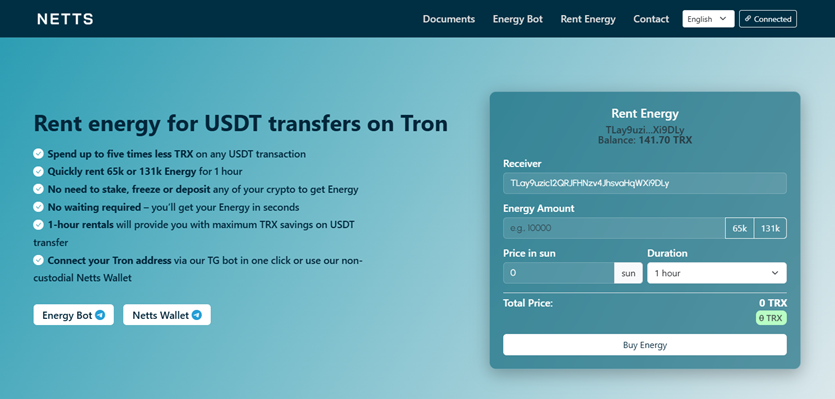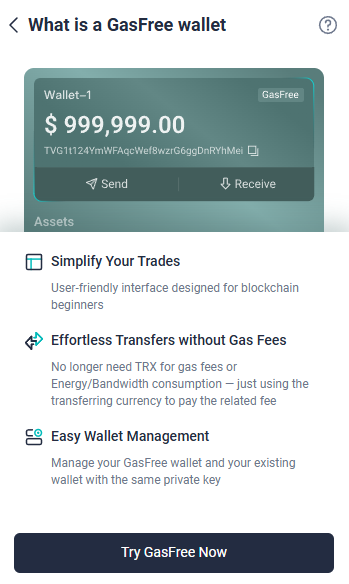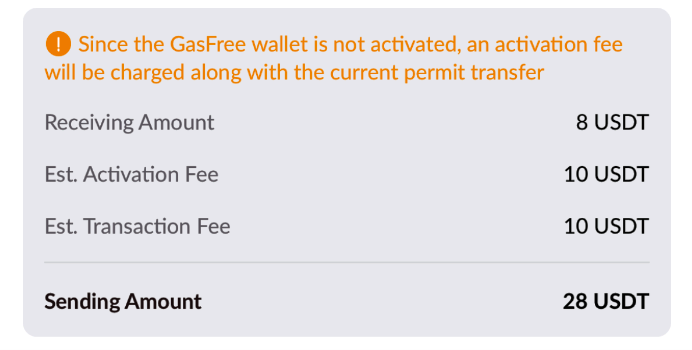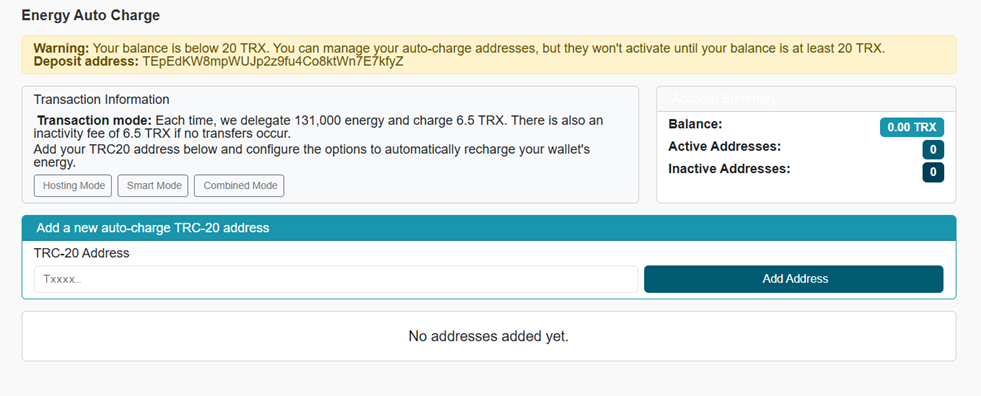GasFree vs. Renta de Energía: ¿Qué elegir en 2025?
The Tron blockchain is a very flexible cryptocurrency eco-platform that provides users with choices in transaction payment methods.
Even when interacting with simple transfers in TRC-10 tokens, you can choose: use TRX or Bandwidth for fee payment.
But Tron offers even more choice to users who interact with smart contracts.
For example, to pay fees for transferring USDT TRC-20, you can now choose the following options:
- only native TRX crypto;
- special resources Energy and Bandwidth + TRX (burned if resources are insufficient);
- only Energy and Bandwidth, if sufficient;
- completely gas-free transaction via the GasFree function — payment in USDT stablecoins.
Much has already been written about ways to minimize expenses by using special resources instead of native crypto,
and active users know that using Energy to pay for transactions is much more advantageous than burning TRX.
This is because Energy can be obtained as a reward for staking a substantial volume of TRX
or, much more conveniently and almost as profitably — renting Energy on special services.
En este último caso, los ahorros en el pago de transferencias USDT TRC-20 pueden alcanzar el 80% en un servicio como NETTS.

Recientemente, otra innovación de Tron causó sensación: usando la función GasFree, un usuario puede evitar el uso de gas (Energy, Bandwidth, y TRX) para pagar comisiones por transferencias USDT TRC-20.
Es decir, en 2025, los usuarios de la plataforma ecológica involucrados en transferencias de stablecoin USDT podrán elegir entre GasFree y alquiler de Energía para pagar estas transacciones de transferencia.
¿Qué opción es mejor? Analicemos los detalles.
¿Cómo funciona GasFree?
GasFree es un mecanismo que permite a los usuarios enviar transacciones sin consumir TRX, Energía y Ancho de banda. The actual commission costs are passed on to the smart contract sponsor (service provider).
Essentially, these are meta-transactions in the Tron ecosystem.
- The user sends a transfer request (in USDT or another TRC-20 token) through a GasFree smart contract.
- The smart contract (sponsor) pays the system costs (TRX, Energy, Bandwidth).
- The user compensates the sponsor for the costs — pays the commission in another token (usually USDT).
This approach simplifies work for users who do not want to complicate their wallet balance with different assets and special resources.
GasFree allows sending USDT TRC-20 without TRX on the balance.
However, the price of such "compensation" can differ significantly from Tron network fees in native crypto and resources.
Because GasFree does not allow transactions with zero commission, but only shifts the commission from TRX to another token.
Ventajas de GasFree
Ausencia total de la necesidad de TRX, así como de otros componentes de gas — recursos especiales de Tron, Energía y Ancho de banda.
Facilidad de uso — envío de transacciones sin configuraciones complejas.
Desventajas de GasFree
- GasFree solo está disponible en monederos y servicios compatibles.

- The service provider can disable GasFree support at any moment.
- Hidden fees or transaction limits may be imposed. By the way, the accompanying documentation includes a disclaimer that the transaction fee may be significantly higher than if the user paid the gas themselves, especially during high network congestion on Tron.
When using GasFree, the commission can be noticeably higher than when using "gas": current tests show amounts of 10–20 USDT per operation.
This is without even considering the payment for activating the GasFree Wallet (another 10 USDT).

¿Cómo funciona el alquiler de Energía?
Alquiler de energía — provisión por un servicio especial durante un período específico (hora o más) de recursos informáticos para reducir la comisión de las transacciones TRC-20.
Such rental allows the user to completely exclude TRX from transaction fees when interacting with smart contracts,
including when transferring USDT TRC-20.
Energía alquilada permite más transacciones con costos mínimos.
Ventajas del Alquiler de Energía
- Commission reduction by 2–3 times compared to regular transfers.
- Availability for any wallets and services.
- Flexibility — you can rent the required amount of energy for different durations.
- Full automation — when using Telegram bots or web interfaces, such as NETTS's Workspace.

Desventajas del alquiler de Energía
Las desventajas de este método podrían incluir la necesidad de calcular el volumen de Energía requerido por adelantado y mantener algunos TRX en el saldo para el alquiler.
Y en el caso de automatizar la recarga, se requiere una configuración inicial.
Algunos usuarios acumulan TRX "extra" también para evitar bloqueos de transacciones en caso de sobrecarga de la red.
Aunque este factor también puede eliminarse simplemente alquilando un mayor volumen de Energía o activando la recarga automática del monedero, si la interacción con contratos inteligentes ocurre bajo condiciones de sobrecarga del sistema.
Por ejemplo, el servicio de alquiler de Energía NETTS permite a sus clientes, que envían USDT TRC-20 a docenas de direcciones diariamente, elegir un modo adecuado para cargar el saldo:
- Host – this is "perpetual" Energy or the second option – resource supply according to a schedule approved by the client;
- Smart – trigger-based Energy supply: as soon as the resource reserves reach the specified level, the balance is replenished to the initial level.
GasFree vs. Alquiler de Energía: ¿Cuál es más rentable?
Comparemos ambos métodos en función de los parámetros clave.
| Parameter | GasFree | Energy Rental |
|---|---|---|
| Is TRX needed? | No | Yes |
| Fixed commission? | No (may depend on the provider) | Yes |
| Works with any TRC-20 tokens? | No (limited support) | Yes |
| Support in all wallets? | No | Yes |
| Suitable for mass transactions? | No | Yes |
| Transaction cost for transferring USDT TRC-20 to one address | from 10 USDT | ~3-6 TRX (depending on recipient's balance) |
Conclusión:
- The GasFree function is useful for large players who do not want to hold TRX and special resources to service a large number of addresses. But they must be prepared to pay an increased commission in USDT for convenience.
- GasFree is not the best choice for the mass audience of Tron users, but for special cases (corporate wallets, exchanges, B2B services) it can be a convenient option.
- GasFree is also convenient for beginners who find obtaining special resources complicated. But the high transaction fees prevent those who regularly interact with TRC-20 from using this method.
- Energy rental is suitable for everyone, including holders of significant USDT volumes and those who regularly transfer stablecoins, interact with smart contracts, and avoid inefficient expenses that can be easily eliminated by renting Energy.
De todo lo anterior, se deduce que en 2025, el alquiler de Energía sigue siendo el método principal para minimizar las comisiones en la red Tron. Es más ventajoso que el staking y mucho más barato que GasFree.
Lo principal es elegir cuidadosamente un servicio de alquiler de Energía. NETTS ofrece facilidad de uso incluso para principiantes en Tron. No se requiere registro ni creación de cuenta. Simplemente inicie sesión a través del formulario del sitio web o el bot de Telegram. Elija el método de pago: pago único preliminar a una tasa de 3–6 TRX por transacción o un depósito de 15 TRX, suficiente para 2–5 transacciones. También puede utilizar la nueva función: recarga automática a través de la interfaz web de Workspace.
Solo prueba cómo funciona y obtén un ahorro real del 80% en el servicio de alquiler de energía NETTS – https://netts.ioDepósito en el espacio de trabajo – solo 1 TRX.